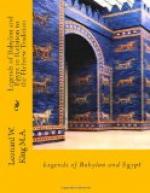From the reference to “my human race” it is clear that the speaker is a creating deity; and since the expression is exactly parallel to the term “my people” used by Ishtar, or Belit-ili, “the Lady of the gods”, in the Babylonian Version of the Deluge story when she bewails the destruction of mankind, Dr. Poebel assigns the speech to Ninkharsagga, or Nintu,(1) the goddess who later in the column is associated with Anu, Enlil, and Enki in man’s creation. But the mention of Nintu in her own speech is hardly consistent with that supposition,(2) if we assume with Dr. Poebel, as we are probably justified in doing, that the title Nintu is employed here and elsewhere in the narrative merely as a synonym of Ninkharsagga.(3) It appears to me far more probable that one of the two supreme gods, Anu or Enlil, is the speaker,(4) and additional grounds will be cited later in support of this view. It is indeed possible, in spite of the verbs and suffixes in the singular, that the speech is to be assigned to both Anu and Enlil, for in the last column, as we shall see, we find verb in the singular following references to both these deities. In any case one of the two chief gods may be regarded as speaking and acting on behalf of both, though it may be that the inclusion of the second name in the narrative was not original but simply due to a combination of variant traditions. Such a conflate use of Anu-Enlil would present a striking parallel to the Hebrew combination Yahweh-Elohim, though of course in the case of the former pair the subsequent stage of identification was never attained. But the evidence furnished by the text is not conclusive, and it is preferable here and elsewhere in the narrative to regard either Anu or Enlil as speaking and acting both on his own behalf and as the other’s representative.
(1) Op. cit., p. 21
f.; and cf. Jastrow, Hebrew and
Babylonian Traditions,
p. 336.
(2) It necessitates
the taking of (dingir) Nin-tu-ra as
a genitive, not a dative,
and the very awkward rendering
“my, Nintu’s,
creations”.
(3) Another of the recently published Sumerian mythological compositions from Nippur includes a number of myths in which Enki is associated first with Ninella, referred to also as Nintu, “the Goddess of Birth”, then with Ninshar, referred to also as Ninkurra, and finally with Ninkharsagga. This text exhibits the process by which separate traditions with regard to goddesses originally distinct were combined together, with the result that their heroines were subsequently often identified with one another. There the myths that have not been subjected to a very severe process of editing, and in consequence the welding is not so complete as in the Sumerian Version of the Deluge.
(4) If Enlil’s name should prove to be the first word of the composition, we should naturally regard him as the speaker here and as the protagonist of the gods throughout the text,




